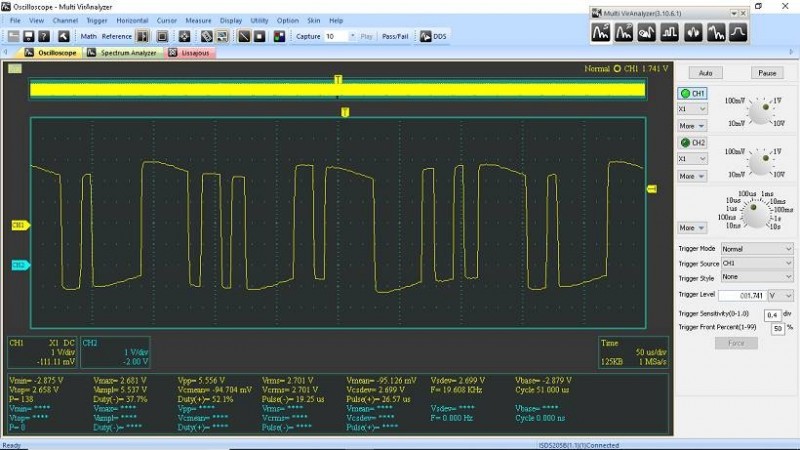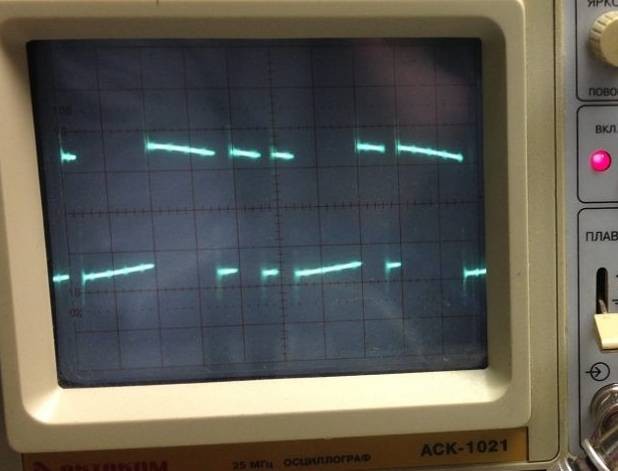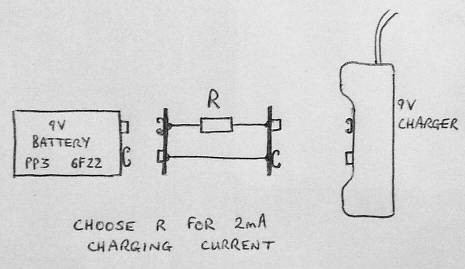-
Posts
565 -
Joined
-
Last visited
Content Type
Forums
Detector Prospector Home
Detector Database
Downloads
Everything posted by PimentoUK
-

Blue Tooth Headphones Fell In Water , Repair Take Apart ?
PimentoUK replied to KD0CAC's topic in Minelab Equinox Forum
Good Job. Regarding: "once the battery dies, it's a throwaway job" That battery ( actually a single cell ) is easily replaced, by one the same size, or slightly smaller if need be. The size is marked on it, which is all you need, really. It tells you the physical dimensions, eg. this "492530" cell is 4.9mm x 25mm x 30mm. So a slightly undersize cell may be lower in capacity, giving a shorter run-time, but that's about all. -
Here's where I drew my info from. The English translation of the MD-Arena website page. Down towards the end of the readers comments [ie. angry Russians arguing ] are a scope screengrab, and some spectrum analysis. MD-Arena page I've attached the 'scope screen photo here, and also an Equinox Beach Mode waveform that Chiv posted on Geotech1. They match ( to my engineers eyes ) , what wasn't detailed was what mode the Vanquish was in at the time. It just may be different in some or other mode. So a little prudence is called for.
-

Where Do You Get Damping Grease In Small Qty's?
PimentoUK replied to kac's topic in Compass, D-Tex, Tesoro, Etc.
This extremely thick grease is sometimes branded as 'Kilopoise' grease ( from the unit of viscosity ), one possible place to look is HiFi specialists, as it's used to damp down tone-arms on high-end turntables. Another possible source I have heard of is for radio-control vehicles. They use heavy grease in limited-slip differentials, one brand is Traxxas: traxxas grease These are just suggestions, I've never used any of these products on detector controls. -
After making some errors yesterday about what I believed were the Vanquish operating freqs, I have some proper facts today: Those Russians over on the MD-Arena website have been poking about on a Vanquish, and have posted a frequency spectrum of it's output, and a 'scope image of its waveform. And the surprise result is .... it's running like the Equinox Beach mode. The waveform is an exact match for the Beach mode scope capture's that Chiv made on Geotech1, and the frequency spectrum matches, too. So that is 7.8 kHz / 13 kHz / 18.2 kHz / 39 kHz Ratios are 3 : 5 : 7 : 15 How it then goes on to process these four is of course unknown .... it could be a straight 'copy' of the Eqx beach mode code, that would be the quickest simplest way of doing it - make use of the R&D that's already been carried out. If they only need to process two freqs for a given mode, they can, no need to change the transmitted output. I suppose this opens up the possibility of hacking Vanquish coils onto the Eqx ... though don't hold yer breath. I'll try and add some pics and further info later.
-
"Not so essential" was meant to infer that the majority of potential customers wouldn't be wanting it to operate completely submerged. I am unsure what the 'Terra' is supposed to be, I'm wary of making assumptions as to what niches it's targeting. I would suggest 'bad dirt' would be a PI strong point, so the lucrative nugget-hunting market would be an obvious direction to develop the AQ.
-
My thoughts: As it's well known that wireless systems work poorly through water, particularly those at 2.4 GHz , the 'water absorption' frequency, it's perhaps no surprise the AQ is corded 'phone only. However it is more viable on a land-based machine, where having a waterproof machine is a good thing, but a submersible one is not so essential.
-
I don't know if FT are getting feedback from this thread, but ... a question was asked on a UK forum about charging both battery packs simultaneously. Based on the above photo, it seems that one at a time is all that's possible , with the charger supplied. Do you, Rick, have any indication of charge time, eg. 5 hours; 16 hours ? The charger's label indicates 400 mA max current output, and it seems likely the pack contains 8 or 10 x AA cells, which would suggest 5 hours is the minimum charge time ( if 2000 mAh capacity cells ).
-
The switches are small, cheap, fairly fragile things, it's almost inevitable that they will fail at some point. You can see them on this internal photo: eqx_PCB The sealed case means no access for repair. And removing/inserting the battery isn't exactly simple, so no get-around there. And I very much doubt that it's possible to do any clever software 'work-arounds', either, like swapping the on/off and the backlight button functions.
-

General Metal Detector Type Question(s)
PimentoUK replied to nopeda's topic in Metal Detector Advice & Comparisons
Ring-shaped objects give a stronger signal than solid discs, and read 'higher up' the discrimination scale that most detectors have. And aluminium is a good electrical conductor. So I think it's worth experimenting with large aluminium washers, example 1" / 26mm size. A UK supplier for illustrative purposes: https://www.gwr-fasteners.co.uk/aluminium-washers-244-c.asp These should be quite distinctive and easily found with a detector, and they're reasonably cheap if you're going to be using lots of them. -

Low Vdi Numbers On F75+
PimentoUK replied to Ronnie Williams's topic in First Texas - Bounty Hunter, Fisher & Teknetics
A simple thing worth trying is to perform a Factory Reset on the machine, then re-set your discrim etc. You may have some inadvertent notching set up, and it's simplest to reset, rather than figure out how to untangle the notch. -
That map of Europe looks a bit 'distorted' to me. I'm sure the UK isn't that big. Not to mention all of Scandinavia and the Baltic States are missing - Norway, Sweden, Finland, Latvia, Lithuania to name a few.
-

Factors Affecting Coin Sink Rates
PimentoUK replied to Joe D.'s topic in Metal Detecting For Coins & Relics
A process known as Bioturbation is a very significant factor in coin sink. Essentially, earthworms disturb the soil around the item, until one dry/wet/cold/whatever day, the conditions allow it to drop 2 or 3 mm. Repeat this for 100 years and your target is 20cm ( 8 inches) down. If the ground is inhospitable to worms, the sink is much slower. Unfortunately for us, earthworms tend to live in the top 30cm ( 12" ) of soil, because that's where the plant matter they eat is located. -
If it's laying on the surface, or nearly, then the obvious thing to try is lowering the sensitivity right down, to 5 perhaps, then you'll only get signals from shallower stuff [ or big stuff deep ]. Try a few experiments with a 'similar' mans ring.
-
Now that is clever, and funny, thanks for posting it. And there's definitely aspects of LRL innards in this diagram. Not just the hot melt glue - there's the non-functional 'decoy' component; the impenetrable jumble-of-wires; the 'Holy Water' and the magic smoke container; the switch that's glued in the 'open' state so it never functions. An obvious omission is a frog's leg, possibly the first electronic component. And a jar of 'Gypsy tears'. I like the inclusion of the electric eel, an under-rated component, for definite. A few in-jokes appear too: you can use a sandal in place of the 'flip-flop' circuit.
-
The raw material is expensive; cutting/bending/drilling/grinding is difficult. Welding is not easy, then the heat-treatment needed for some of these fancy steels is quite elaborate. Not just heating to fairly high temperatures then slowly cooled, as you might expect - but it can also include immersion in liquid nitrogen baths to force the 'age-hardening' process. There is a 'How it's made' episode on top-end kitchen knives, they get the nitrogen treatment, I think it's this one: kitchen knives Some background on these steels: wiki maraging steel
-
This is what they should be made of: Maraging stainless steel. 250-stainless Reynolds953 Super strong, and (reasonably) corrosion-resistant And marketing it would be easy, simply saying it's used in military aircraft landing gear should be enough. Some baboon would no doubt manage to bend a digger made from it.....
-
Well I've just purchased a couple of EBL Lithium 9V batteries from one of the big sellers on eBay UK. The price is reasonable, at 5 GB Pounds each, many of the NiMH ones are 7-12 Pounds, even the ones I could get from trade suppliers like Farnell Electronics were expensive. I also had a rummage around in my electronics stuff, and remembered I had 5 small foil-pouch Li-polymer cells, brand new. When I found them I tried them in the Propointer battery compartment, and found they actuall fit, at a jaunty angle... . So that's a little project, making a custom lithium PP3, I will post pics when it's done. mh9 probably won't like it, hehe, but the economics make sense, these cells were 1 Pound for all 5, I recall. Capacity is 300mAh, perfectly decent.
-

British Coin And Other Finds
PimentoUK replied to RobNC's topic in Metal Detecting For Coins & Relics
Newton was also "Master of the Mint" at the Royal Mint, another reason for him featuring on the coin. You're correct about aluminium, or alloys of it, being corrosion-resistant. I've dug a French coin from 1922, and it came up shiny and pale gold coloured. It had me puzzled for a while, the weight was clearly light, so I suspected aluminium. It turned out to be aluminium-bronze, which was a new alloy at the time, though it has been used for a great many coin issues worldwide since then. -

British Coin And Other Finds
PimentoUK replied to RobNC's topic in Metal Detecting For Coins & Relics
You will struggle to get a bi-metallic 2 Pound coin to look decent, mechanical methods are the most viable. The cupro-nickel centre is the same metal as your US 5 cent coin. The pale gold outer ring is 'nickel bronze', both have an enthusiasm for turning brown quite quickly. Some pictures: two pounds The theme of the coin is Science, and the UK's contribution to it. It features gears (the Industrial Revolution), computer chips, and a representation of the Internet. The "STANDING ON THE SHOULDERS OF GIANTS" edge inscription is a reference to British scientist Isaac Newton using it. Though it turns out to have a history much older than that: s.o.t.s.o.g -
I thought someone would ask! To recharge alkaline 9V batteries: You need to do it at 2 milliamps, or thereabouts, and obviously for a long time, like 12 - 24 hours. It's generally thought best to charge them soon after discharge, rather than days after. A practical way is to make up a break-in charging cable, to go between the standard 9V charger terminals and the battery, with a suitably chosen resistor in series, to drop down the current. From memory, I think my cable had a 820 Ohm resistor. The two battery connectors could be the commercially available 'snaps' with two flying leads, or the end of a dead battery can often be salvaged, and wires soldered onto it. Sketch of adaptor:




